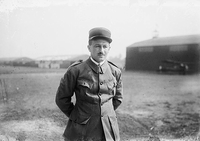Georges Thenault
| Georges Thenault | |
|---|---|
 
Captain Georges Thenault, French Aviation Service, at Langley Field, Virginia, 4 October 1922
|
|
| Born |
15 December 1887 Celle-Lévescault, France |
| Died | 19 December 1948 (aged 61) Paris, France |
| Buried at | Crypt of the Lafayette Escadrille Memorial in the park of Ville-neuve L'etang, between the suburbs of Garches and Marne la Coquette |
| Allegiance | France |
| Service/branch | French Aviation Service |
| Years of service | August 1914-1937 |
| Rank | Lieutenant Colonel |
| Commands held | Escadrille C.42, détachement de l'armée de Lorraine (D.A.L.), as commanding officer; Lafayette Escadrille N.124, as commanding officer |
| Awards | Légion d'honneur, Croix de guerre, with four Palms |
Lieutenant ColonelGeorges Thenault (French pronunciation: [ʒɔʁʒ təno]) was the commander of the Lafayette Escadrille - the famed branch of the French air force in World War I composed of American volunteer pilots. The Lafayette Escadrille was created before the United States gave up its neutrality, and joined France and Britain in the war against Germany. Once the United States formally entered the war, the Lafayette Escadrille was absorbed into the U.S. Army.
Born December 1887, small town of Celle-Lévescault, France (located on main highway between La Rochelle and Tours).
Standing 5-ft, 8-in, he was a giant in the eyes of his fellow Frenchmen and a respected leader amongst the American volunteer pilots. Identified as N.124, the Lafayette Escadrille was assigned to Groupe de Combat 13 under the overall command of Commandant Philippe Féquant. During 1916-1917, this Groupe de Combat 13 took part in such engagements as the Battle of the Somme, the Second Battle of the Aisne, the Battle of Verdun, and in the Battle of Passchendaele. In early 1918, it operated in the region between Soissons and Reims.
Captain Georges Thenault credits Adjudant Norman Prince for conceiving in November 1914 the idea of bringing together his countrymen with some of those of the French Foreign Legion in a squadron of flyers. Support soon came about from civilian and military representatives of France and the United States. These representatives added expertise and government networking resolving over time the method of recruiting and financing, and successfully encountering the French officialdom. Five influential men instrumental in providing this organizational support included:
This team of five experts identified the many issues involved and the obstacles that had to be overcome, and helped the first American volunteers to develop a plan:
...
Wikipedia
